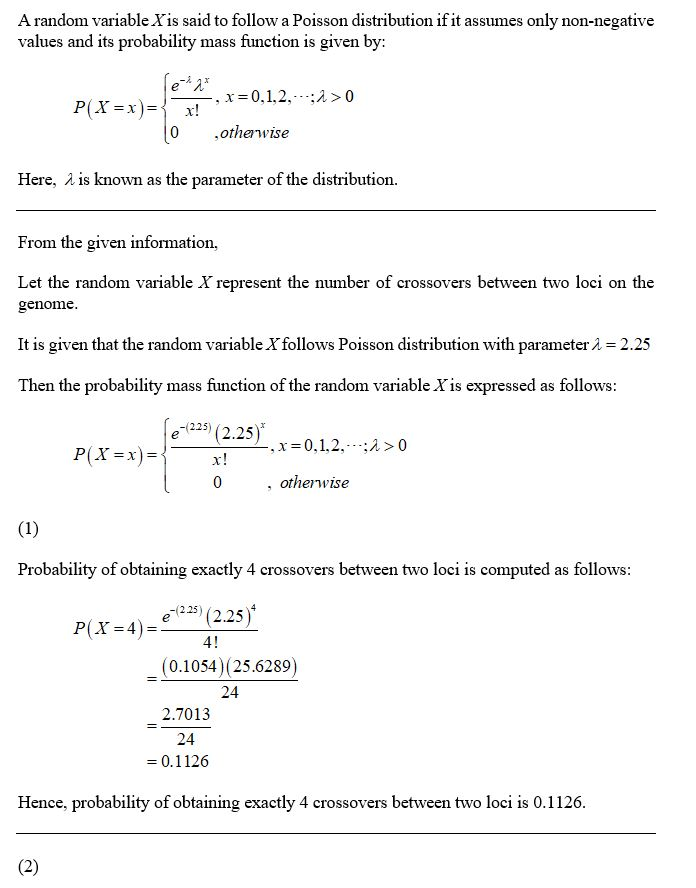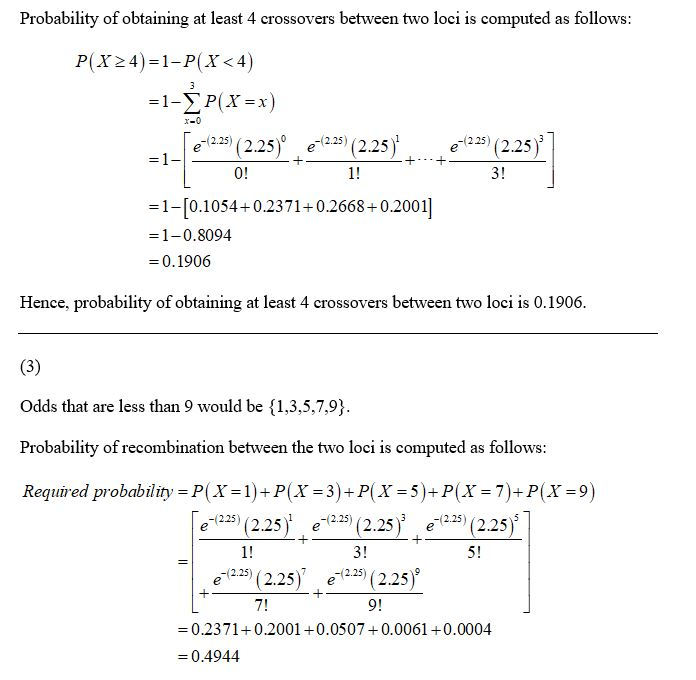Question
In: Math
Meiosisis the process in which a diploid cell that contains two copies of the genetic material...
Meiosisis the process in which a diploid cell that contains two copies of the genetic material produces an haploid cell with only one copy (sperms and eggs). The resulting molecule of genetic material is linear molecule that is composed of consecutive segments: a segment that originated from one of the two copies followed by a segment from the other copy and vice versa. The border points between segments are called points of crossover. The Haldane model for crossovers states that the number of crossovers between two loci on the genome has a Poisson(λ) distribution. Assume that the expected number of crossovers between two loci in a fixed period of time is 2.25.The next 3 questions refer to this model for crossovers. (The answer may be rounded up to 3 decimal places of the actual value.)
1. The probability of obtaining exactly 4 crossovers between the two loci is
2. The probability of obtaining at least 4 crossovers between the two loci is
3. A recombination between two loci occurs if the number of crossovers is odd. The probability of recombination between the two loci is, approximately, equal to ??? (Compute the probability of recombination approximately using the function "dpois". Ignore odd values larger than 9)
Solutions
Related Solutions
Structure/ Function Animal Cell Structure Plant Cell Structure Outer Boundary of the Cell Contains Genetic Material
For a diploid mouse cell (40 chromosomes), state how many copies of each are present at...
4. Identify two meiotic events that promote genetic variability. 5. If a cell has a diploid...
Provide two reasons why the process of meiosis leads to genetic variation in diploid organisms.
A human diploid cell at G1 contains 6 picograms of DNA. A human cell at metaphase...
identify the genetic material for hereditary information inside the cell
A diploid organism produces four gametes from one parent cell through the process of meiosis. Two...
A diploid organism produces four gametes from one parent cell through the process of meiosis. Two...
Which of the following is FALSE about a mushroom A. it contains haploid, dikaryotic, and diploid...
Describe the mechanisms by which meiosis would introduce genetic variability in a population. If one diploid...
- Accounting for foreign currency transactions MyBeauty Ltd is an Australian company which specialises in manufacturing...
- The general ledger of the Karlin Company, a consulting company, at January 1, 2021, contained the...
- In Linux Professional: PE15 (CH) 1 – why is the max RAM for a 32-bit OS...
- Use the following words to script that mirrors a conversation that you might have with a...
- I need C++ code Given the complete main() function, partial playlist class header playlist.h, and playlist.cpp,...
- "Elizabeth Egbert owns a galvanizing plant. Customers bring in their fabricated steel products (like light poles,...
- Write a general-purpose program with loop and indexed addressing that adds 12h to 0th, 3rd ,...


 milcah answered 1 month ago
milcah answered 1 month ago